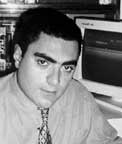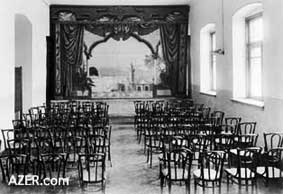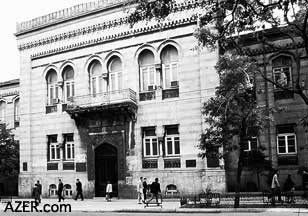|

Autumn 2002 (10.3)
Memories
Baku's
Institute of Manuscripts
by Farid Alakbarov
  This past spring, Baku's Institute of
Manuscripts celebrated the 100th Jubilee of its unique building.
Originally, this structure housed the Alexandrian Russian Muslim
Female Boarding School, the first girls' school in the Muslim
East, built by oil baron and philanthropist Haji Zeynalabdin
Taghiyev (1823-1924) at the turn of the 20th century. Ever since
1950, this former school has been used to house the Institute
of Manuscripts and its collection of rare medieval Eastern texts. This past spring, Baku's Institute of
Manuscripts celebrated the 100th Jubilee of its unique building.
Originally, this structure housed the Alexandrian Russian Muslim
Female Boarding School, the first girls' school in the Muslim
East, built by oil baron and philanthropist Haji Zeynalabdin
Taghiyev (1823-1924) at the turn of the 20th century. Ever since
1950, this former school has been used to house the Institute
of Manuscripts and its collection of rare medieval Eastern texts.
The Institute currently archives about 40,000 works in languages
that include Azeri, Turkish, Uzbek, Persian and Arabic. These
texts reveal what Azerbaijanis from the Middle Ages thought about
medicine, astronomy, mathematics, poetry, philosophy, law, history
and geography.
In addition, the Institute of Manuscripts houses many valuable
documents from the private collections of famous Azerbaijanis
in its Department of Private Funds. In many cases, families have
donated entire collections of unpublished papers and letters
to the Institute, where these documents are then kept, investigated
and published. Artifacts include diaries, memoirs, photos and
documents from the 19th century and early 20th century.
Photos:
The building that now houses
Baku's Institute of Manuscripts was originally built as the first
girls' school in the Muslim East by Oil Baron Philanthropist
Haji Zeynalabdin Taghiyev (1823-1924).
Taghiyev was convinced that if you could educate women, you would
educate your entire population.
Some of these girls became the mothers of prominent contributors
in Azerbaijan. The school, which was called the Alexandrian Russian
Muslim Female Boarding School, was designed by Polish architect
Joseph Goslavski and was under construction from 1898-1901. The
school operated for nearly 18 years.
Despite the fact that the Bolsheviks confiscated all of Taghiyev's
property, his personal album of photos still exists within the
family and are published here courtesy of Saida Mirizade.
Classes not only provided basic education but gave girls the
opportunity to learn music and drama as well.

 |
 |
 |
 |
For instance, the Institute archives the private funds of (1)
composer Uzeyir Hajibeyov (1885-1948); (2) writer and philologist
Yusif Vazir Chaminzaminly (1887-1943); (3) journalist Ali Abbas
Muznib (1883-1938), a researcher of Azeri literature and an editor
of satiric magazines; (4) writer Abbas Sahhat (1905-1973), a
researcher of Azeri literature; (5) 19th-century writer/historian
Abbas Gulu Agha Bakikhanov, author of the first European-style
book on Azerbaijani history; (6) Mirza Fatali Akhundov (1812-1878),
a writer, reformer and playwright; (7) Ali Agha Shikhlinski (1863-1944),
an important military strategist, general and inventor; (8) Mirza
Kazimbey (1802-1870), a scholar and linguist; (9) Mikayil Mushfig
(1908-1939), a dissident poet who was killed during Stalin's
Repression (see article in this issue); (10) distinguished Azeri
actor Huseingulu Rezayev (1879-1945), who was known by the stage
name "Sarabski" and played the first Majnun in Hajibeyov's
1908 opera "Leyli
and Majnun" (see article in this issue); (11) and Mursal
Najafov, who left a memoir of his friend, artist Sattar Bahlulzade
(1909-1974). There are numerous others as well.
The Institute also houses the letters, diaries, scores and librettos
of Azerbaijani composer Muslim Magomayev (1885-1937), including
valuable information about his collaboration with composer Uzeyir
Hajibeyov. One of these librettos is that of the "Shah Ismayil"
opera written by Magomayev in 1916.
_____
From Azerbaijan
International
(10.3) Autumn 2002.
© Azerbaijan International 2003. All rights reserved.
|






